During the Jomon to Heian period in Japan, women were quite powerful in government sectors and had many different roles in public and private. They were highly educated and had many cultural achievements that should be praised. Before the Heian period, women were very powerful and tended to be empresses ruling over the country. Even though their power came to a half during the Heian period, they were still quite respected. Japanese women became even more immersed in their culture and started producing amazing art and literature that continues to live on. These women were high achievers and loving mothers, happily taking over both jobs. Their commitment to their families and culture is represented through all forms of art throughout the history of Japan. Whether they were shown in a government, societal, or private and loving setting, women are frequently subjects in art.
When breaking down each period we can see the important roles that women played in growing Japan as a country and society. In public women had multiple different parts that they played through time. The Jomon period saw women gathering food and managing domestic tasks. They played a crucial role in the community – this era emphasizing women’s important contributions to culture and work. As society moved towards the Yayoi period, the introduction of agriculture was crucial in expanding women’s roles beyond mere household duties. There weren’t any specific gender roles within agriculture, with men and women working side by side. But there were constraints that these women faced. When moving onto the Heian period, culture started to flourish with women writing and making art. The court changed to male dominant and the women took this as a chance to freely express themselves. In private life, they raised children, managed households, and maintained social connections which was an important influence within families. The Heian era saw a change in their clothing and hairstyles, reflecting their status and identity. Women had many different roles from the Jomon to Heian periods in Japan. Whether it was public or private, they were and still are important to grow society.
When looking at the medieval to early modern period, women started to have different roles in society. These roles were just as important as during the Heian period but they were much simpler. Women were seen as less that men in feudal Japan but they were now able to become warriors to protect their families and homes. In private they were still mothers for their children and made art and literature but in public could be aristocrats or samurais.
Even though women were belittled at times, they were still quite strong during all of these periods and continued to shine.
Written by Julia Boucher, William Spencer, and T Davis
The Heian Period
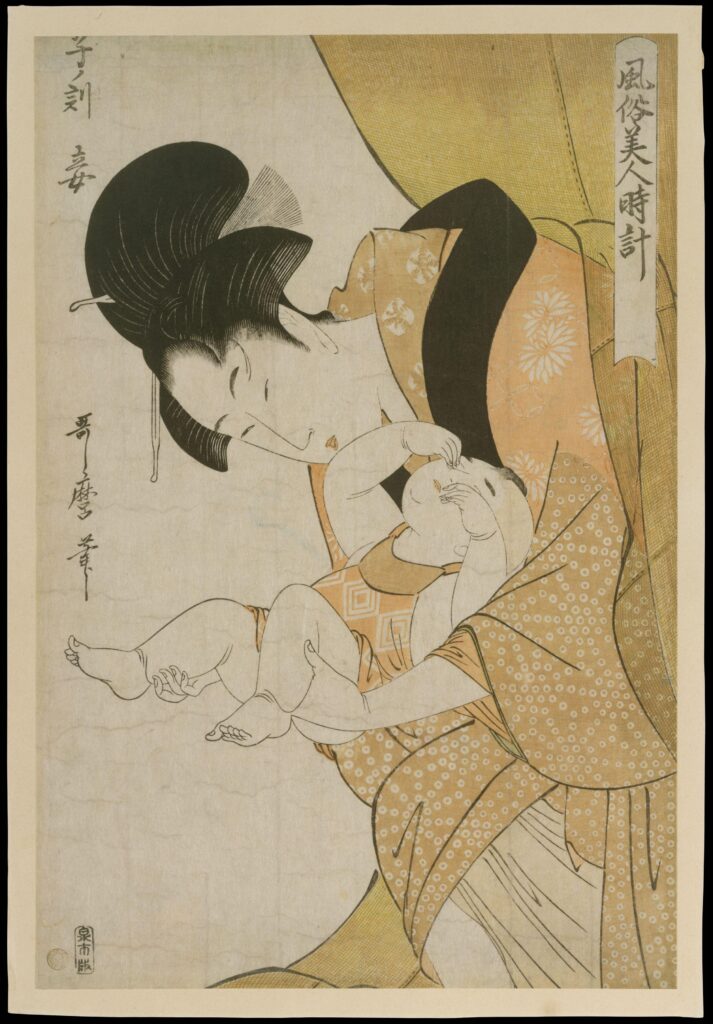
“Midnight: Mother and Sleepy Child”
This print is called “Midnight: Mother and Sleepy Child” by Kitagawa Utamaro depicting a mother holding her child as they fall asleep. It was made during the Edo period in 1790 by using a woodblock print. Throughout time in all societies, women have had an important role in their private lives as a mother. In this print, this mother seems to be possibly aristocratic or quite wealthy from her clothing. This is important to note because when thinking of the Heian period, childbirth was very dangerous, but if a woman had the money to provide for proper care then the birth would go smoother and be healthier for the mother and child. At first you would assume that an aristocratic household would bring a peaceful and calm birth, but the space for labor was filled with a lot of commotion. Childbirth was seen as an overlap between the worlds of living and dead, which meant that both medical and ritual assistance was needed. When thinking about the social aspects of women and the children – especially in the realm of royalty – the women tended to have a lot of power and more control than you would think during these periods. There is also an institutionalized role of the imperial mothers and sometimes grandmothers to be caretakers of emperors as well. The role of mothers and how children were reared is quite different from many other cultures, but their love for each other is always present.
Written by Julia Boucher; Source: Andreeva, Anna. “Childbirth in Aristocratic Households of Heian Japan.” Dynamis 34, no. 2 (2014): 357–76. https://doi.org/10.4321/S0211-95362014000200005.
“A Cherry-Viewing Excursion by a Noble Lady and Attendants”
This print is called “A Cherry-Viewing Excursion by a Noble Lady and Attendants” by Chobunsai Eishi depicting a group of aristocratic women observing the beautiful cherry trees around them. It was made during the Edo period in 1797 by using a triptych of woodblock print. When looking back to the periods of Jomon to Heian women had control of the country. Until the 8th century there were multiple empresses that reigned. But when Japan entered their Heian era, women had lost their power. When new political systems and bureaucracy was introduced (specifically Chinese) it brought patriarchal views which cut out women from working in the government. But their social position was still quite high because they were very educated and were able to inherit property. The women depicted in this print don’t have the power that they might have had decades ago, but they still had a lot of influence within their family and social systems. Many of these high ranking women that are depicted in images like these, produced amazing literature in the Heian period, “The Tale of Genji” is an example of the most well known pieces to come from Japan. These pieces of literature were narratives about life in aristocratic society and what was going on behind the scenes. The women displayed in this work are an example of the educated socialite society that was an important part of Japan’s culture.
Written by Julia Boucher; Source: “Women in World History : MODULE 2.” Accessed November 2, 2024. https://chnm.gmu.edu/wwh/lessons/lesson2/lesson2.php%3Fs=0.html.
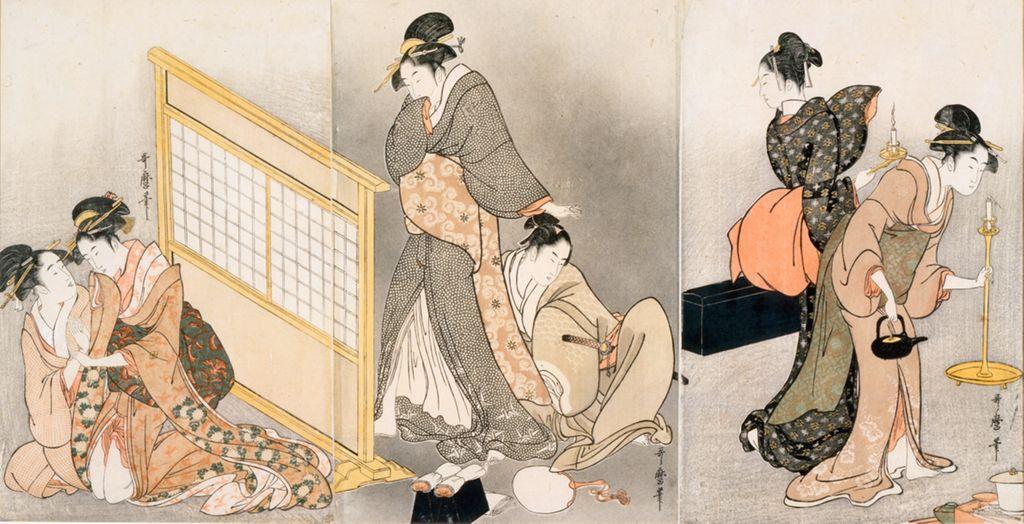
“The Unwilling Lover”
I was drawn to Kitagawa Utamaro’s The Unwilling Lover, an illustration of The Tale of Genji. This image captures the complex relationships during the Heian period and serves as a commentary on women’s roles in both public and private spheres. Utamaro’s image displays a sense of reluctance from the female figure. Her body language suggests an emotional struggle, reflecting the limited agency that women often had during this time in their relationships. This theme is apparent within the narratives in The Tale of Genji, where characters like Murasaki and Lady Fujitsubo navigate the conflicting demands of personal desire and societal expectation. Their experiences highlight the tension between individual emotions and the roles imposed by Japanese society. As described in Japan Emerging, Ch. 4: “Defining ‘Medieval,’” the transition to a more defined class contributed to a societal structure that often had women in the background. While women wielded some influence through their relationships, they primarily operated within the confines of their domestic roles. Utamaro’s image captures this tension, illustrating the emotional burdens women have as they navigate their lives while longing for more significant societal roles.
Written by William Spencer; Source: Japan Emerging, Ch. 4: “Defining ‘Medieval,’” “Summary of The Tale of Genji.” Summary of the Tale of Genji, www.taleofgenji.org/summary.html.

“The Late Heian Era Warrior Taira no Kiyomori,
The Late Heian Era Warrior Taira no Kiyomori”
This image helps to depict the role of women within the context of power in the Heian period. The women’s presence in the court depicted above played a critical role in shaping political outcomes in Japan during this period. The societal structures described in Sources of Japanese Tradition, Ch. 7: “Kūkai and Esoteric Buddhism,” illustrate the significance of connections and alliances, many of which were facilitated through marital connections. This mixture of gender roles with political power highlights how women used their influence in the shadows. The image also reflects the cultural values of the period. The attention to the luxurious setting contributes to an understanding of the Heian period’s emphasis on beauty and refinement, as discussed in Sources of Japanese Tradition, Ch. 9: “The Vocabulary of Japanese Aesthetics I.” The interior space, filled with various figures, serves as a visual picture of how power worked during this period. The image suggests that the court was more a political stage than anything else. Kunisada II image encapsulates the intricate social court life of the Late Heian period. By viewing this artwork within the context of our course readings, we can appreciate the complex dynamics of power, gender, and culture that this image displays. It serves as a reminder of the roles women played within the shifting landscapes of authority and influence during the Heian period.
Written by William Spencer; Source: Sources of Japanese Tradition, Ch. 9: “The Vocabulary of Japanese Aesthetics I.” Sources of Japanese Tradition, Ch. 7: “Kūkai and Esoteric Buddhism”
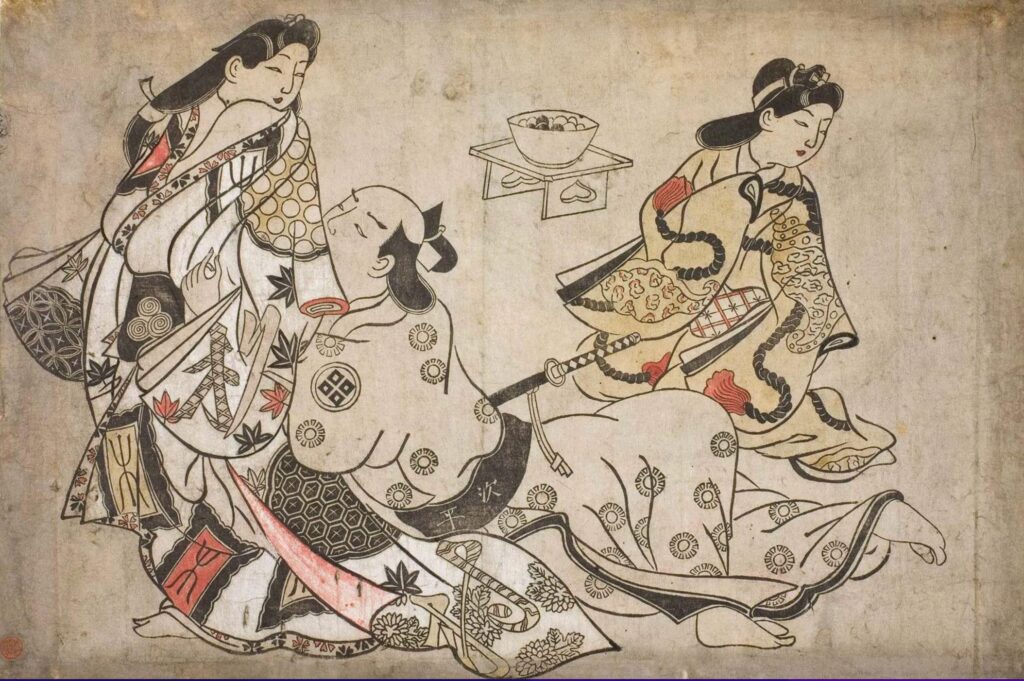
“The Insistent Lover”
I thought this image was similar to another I included in the museum, The Unwilling Lover. It also captures a scene in which a woman is being pursued by a man, where she is seeming less interested. Both works highlight the gender roles of women during this time. In the Heian period, women often had limited autonomy, especially in romantic affairs, as many marriages were arranged, and the woman’s role was defined largely by her relationships with men. Both works examine these power dynamics, with the woman’s resistance symbolizing her complexity and agency within the constraints of her societal role. There was not much women could do in this period, and in relationships love was often not the most important factor. Political status was seen as more important and people would try to move up in status by making marriages that increase their status. As you see in the image the man is carrying a sword, and during this period warriors were very important, so he might have higher status, so their relationship might be good for her family.
Written by William Spencer

“Matsuura Byobu II”
This image showcases a traditional Japanese byobu, vividly illustrating the lives of women during the Heian period. Each panel depicts scenes of elegance and cultural richness, from musical performances to intimate conversations. The women are adorned in luxurious kimonos, detailed with intricate patterns that reflect their high social status and the artistic sensibilities of the time. This artwork serves not just as a decorative piece, but as a historical document, offering insights into the daily activities, social interactions, and the prominent role of aesthetics in Heian society. The colors are vibrant, the composition dynamic, and each scene is a window into a past world, highlighting the sophistication and grace of these historical figures. This piece not only celebrates the artistic achievements of the period but also honors the nuanced roles women played in their cultural and social spheres.
Written by T Davis; Source: unknown, and painter: unknown Japanese. Matsuura Byobu II [6-Panel Screen with Women of Fashion at Leisure]. colors, gold paper, painting (image-making), 1600-1650. JSTOR, https://jstor.org/stable/community.14456948. Accessed 11 Dec. 2024.
The Medieval Period
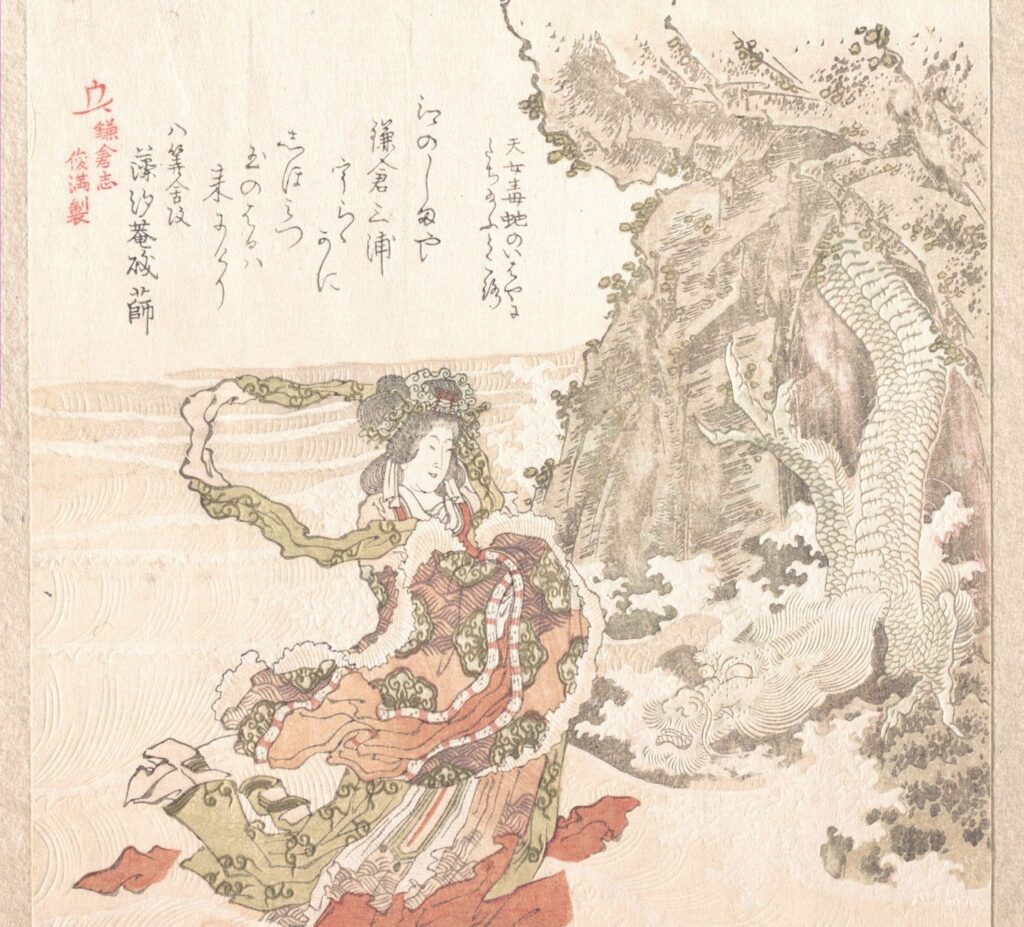
“History of Kamakura”
This delicate artwork from the 19th century by Kubo Shunman depicts a serene scene, intertwining Japanese folklore with natural elegance. A woman, possibly a noble or a figure from a legend, is seated gracefully by the water’s edge. Her elaborate kimono and refined posture suggest her high status and the cultural appreciation of beauty and grace in Japanese society at the time. Beside her, a majestic dragon emerges from the mist, symbolizing strength and wisdom. The composition blends human tranquility and mythical power, evoking a sense of balance and harmony with nature. This piece is a beautiful representation of the themes and artistic styles of the Kamakura period in Japan, blending human figures with mythical elements to create a narrative that feels both ancient and timeless.
Written by T Davis; Source: Artist: Kubo Shunman (Japanese, 1757–1820). History of Kamakura. Woodblock print (surimono); ink and color on paper, 19th century. The Metropolitan Museum of Art, JSTOR, https://jstor.org/stable/community.18678926. Accessed December 11 2024.
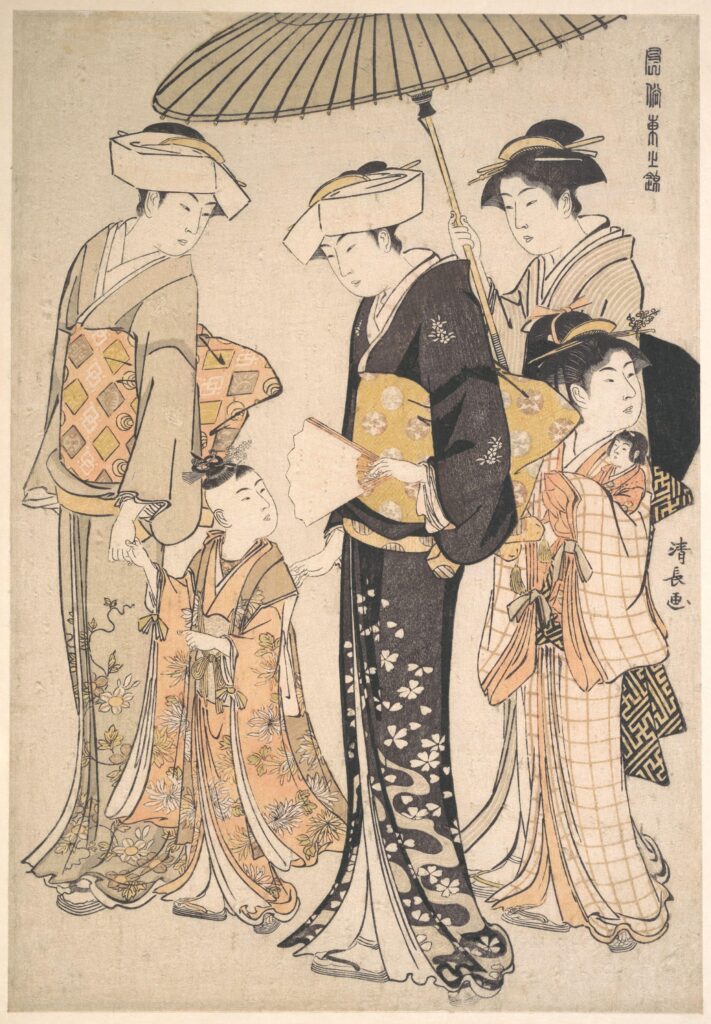
“High-Ranking Samurai Girl with Four Attendants,
from the series A Brocade of Eastern Manners”
This print is named “High-Ranking Samurai Girl with Four Attendants, from the series A Brocade of Eastern Manners” and depicts a woman samurai with attendants around her. At this time during the medieval periods, women samurai’s did exist but they just weren’t not as popular as male samurai’s. But they were nonetheless just as important as the men – they were able to balance raising children and fighting for their country. The women had to succumb to fighting because it came to a point where families needed more protection and the only answer was to teach their daughters all about war. Even though they didn’t fight as much as men they were still important to women’s history and to add numbers to the samurai class. It mainly came to specific women protecting and defending their homes when samurai’s weren’t there to do it for them.
Written by Julia Boucher; Source: Travel Content Creators. “Female Samurai: Japan’s Forgotten (And Erased) Warriors,” December 22, 2022. https://www.travelcontentcreators.com/female-samurai/.
The Early Modern Period
“Zojo-ji Temple in Shiba”
This color woodcut is called “Zojo-ji Temple in Shiba” by Ando Hiroshige which was made during the Edo period in 1854. It depicts women approaching and leaving a temple entrance, in the background there are others loitering. The Zojoji temple was the temple of the Tokugawa shogunate family. The shogunate was a military dictatorship from 1192-1867 which was during the time this woodcut was depicted. But the shogunate government was not the only thing to take into consideration when looking at the early modern period in Japan – like the different roles that women had. As many other cultures, women were seen as less than men, specifically when thinking of feudal Japan. But during the reign of shogunates and samurais, there were many female warriors. They fought alongside other samurais to defend their home and families. Women in Japan at this time had a lot of duality – fighting in battles while also taking care of children and writing poetry. And though this depiction doesn’t necessarily show it outright, it shows the presence of women during the shogunate periods. They still kept to their religion and family care, and what they wanted to do even if there were hurdles in the way.
Written by Julia Boucher; Source: Reddy, Sash. “Library Guides: Shogunate Japan: Women.” Accessed December 3, 2024. https://library.norwood.vic.edu.au/c.php?g=942889&p=6848734.
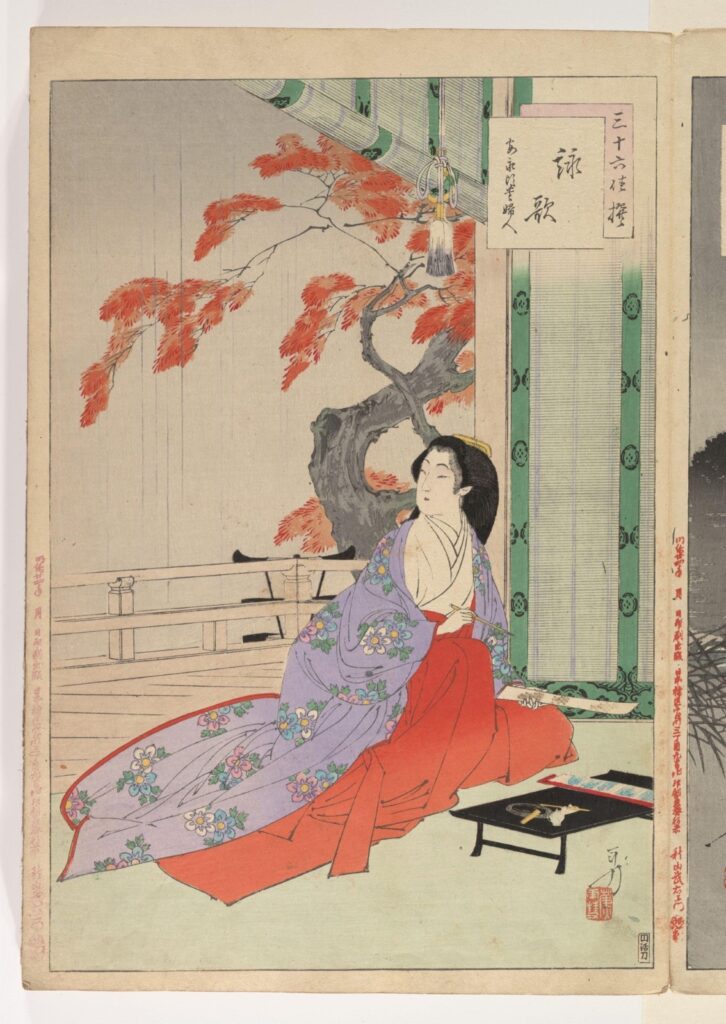
“Noblewomen of the Tokugawa Period; Thirty-Six Beauties”
This print by Mizuno Toshikata, from the late Tokugawa period, captures a noblewoman in a contemplative moment. Dressed in a flowing kimono adorned with floral motifs, she sits beside a wooden veranda, her gaze directed towards a vibrant red maple tree. The scene is tranquil, emphasizing the beauty and quietude associated with Japanese aesthetic principles. Elements like the hanging lantern and the neatly arranged calligraphy set suggest a setting of refinement and cultural richness, where poetry or letter-writing might be enjoyed amidst the changing seasons. This artwork beautifully conveys a sense of serene introspection and the traditional lifestyle of Japanese nobility.
Written by T Davis; Source: Artist: Mizuno Toshikata (Japanese, 1866–1908). “Noblewomen of the Tokugawa Period; Thirty-Six Beauties (Sanjuroko Kasensoro.” Noblewomen of the Tokugawa Period; Thirty-Six Beauties (Sanjuroko Kasensoro [1984.210.1–.72], Album of 72 woodblock prints; ink and color on paper, 1891–93. The Metropolitan Museum of Art, JSTOR, https://jstor.org/stable/community.18693871. Accessed 11 Dec. 2024.

“Two Women Reading”
This elegant Japanese print by Isoda Koryūsai captures a serene moment between two women engaged in reading or viewing a scroll. Positioned in a natural setting, possibly under a willow tree, the women’s flowing robes and elaborately styled hair emphasize the grace and artistic beauty of the Edo period. The vertical composition of the print highlights the length of their robes and the gentle curve of the tree, creating a harmonious and balanced scene. This artwork not only showcases the refined aesthetic of the time but also reflects the cultural importance of literacy and art among women in historical Japan.
Written by T Davis; Source: Isoda Koryūsai. Two Women Reading. colour woodcut. <a href=”https://www.tepapa.govt.nz”>Museum of New Zealand – Te Papa Tongarewa</a>; Collection: Art; Purchased 2016, JSTOR, https://jstor.org/stable/community.27018753. Accessed 11 Dec. 2024.
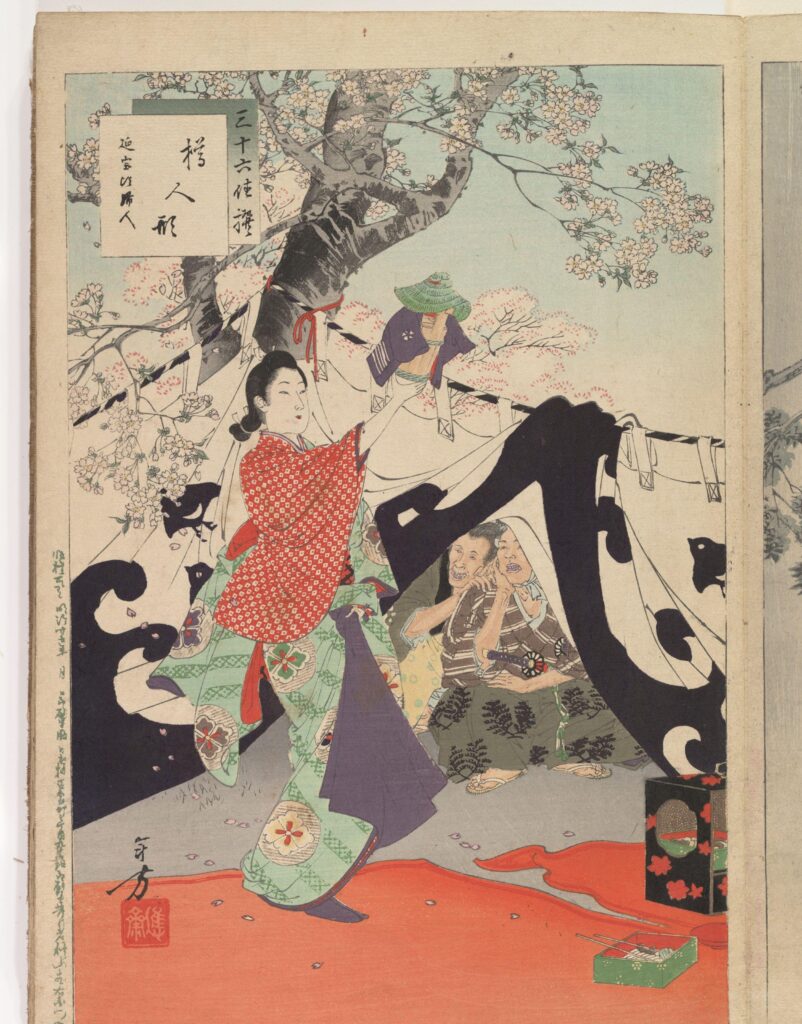
“Noblewomen of the Tokugawa Period; Thirty-Six Beauties”
In the image depicted above you can see a woman, who is dressed in very elegant attire. Based on the title Noblewomen of the Tokugawa Period; Thirty-six Beauties, she is most likely of noble birth. In the image she is hanging her laundry on a wire which is how people back in this time period would have had to do laundry. The most striking part of this image to me, is the way that the men are depicted in the image. You can observe them looking intently up at her while they sit on the ground observing her work. Based on the sword attached to one of their hips these are most likely warriors trying to court this noble woman. Back in this period marriage especially was not done out of love, and more to gain power and influence for their family. As established previously it is most likely her noble birth rather than her beauty that is driving the men to be interested.
Written by William Spencer